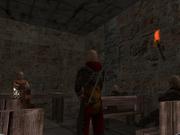Mistmare is more punishment than game. No matter what the box says, this isn't so much a fantasy role-playing game as it is a medieval torture device right up there with the rack and the iron maiden. Slovenian developer Sinister Systems has gotten almost nothing right here, shipping an unfinished product that contains hundreds of bugs, abysmal play mechanics, and Byzantine dialogue littered with typographical errors.

Both out of the box and with the version 1.6 patch, the third-person wannabe role-playing epic is all but unplayable due to graphics and control problems. The mouse cursor floats around the screen, always a split-second behind your hand. Graphical slowdown turns even simple movements into a frustrating slideshow. Even on a machine that far surpasses the recommended system requirements, many areas drop the frame rate down to 10 frames per second or so. One of these locations includes about a third of the monastery where the game begins, so you can forget about starting off on a good note.
You can add to these problems a twitchy camera system that pans back by itself and begins to rotate when the cursor gets anywhere near the edge of the screen. The resulting combination makes accomplishing basic tasks such as opening chests and casting spells excruciating. Clicking on dialogue responses and maneuvering the cursor into the right spot so you can navigate a standard hallway are challenges in themselves. Getting to a doorway without stutter-stepping into every nook and cranny in a room is cause for celebration.
The game's point-and-click melee combat is even more frustrating. The unreliable mouse and camera controls make it hard to get your cursor onto stationary objects, let alone moving monsters that are trying to kill you. Thankfully, you only have to double-click an enemy once to activate the automatic combat mode that keeps you swinging your sword no matter where the cursor is situated.
These crippling problems overshadow everything about Mistmare, even its few good points. Sinister Systems has at least come up with an original gameworld set in an alternate reality where history went off the rails in the 13th century. After the Christian church discovered a way to end the Black Death by using magic, an evil fog descended on much of the continent. Southern Europe was cut off from the rest of the world, keeping Columbus at home in 1492 and dragging the medieval era into the late 20th century. When you take the role of Isador, a warrior monk tasked by the Vatican with finding a man condemned by the church, the calendar may say 1996, but the cobblestone streets and torchlit rooms indicate a much earlier era.
But very little is done with this interesting locale. Plot points are weighed down with ridiculously overwritten (the typical paragraph is at least 200 words in length), typo-strewn dialogue that twists and turns and has no payoff at the end. Adding insult to injury, the developers keep you awake through these interminable conversations by forcing you to manually scroll the text window. The voice acting matches the extravagant text, in that it's so florid and enthusiastic that it practically comes off as sarcastic.
The game's graphics are barren and dark. Although Mistmare was developed with the same LithTech engine that powers the cheerful No One Lives Forever series, this game's grim color palette sticks to earth tones that never stray far from the funereal. This is perhaps fitting for a land shrouded in spooky fog, but Sinister Systems could at least have provided a way to increase the brightness so that we could actually see some of this soul-crushing gloom and doom. As it is, the game might as well be set in a closet.
Character development in Mistmare mainly consists of stock fantasy RPG material. Isador's character sheet tracks attributes like strength and agility and learned combat skills. A journal runs down all of the current objectives. Items are stored in your inventory or enabled with a single click. Most of these items are also standard RPG stuff. While this may be a Christian world more beholden to St. Paul than J.R.R. Tolkien, you still wield magical swords and gulp down healing potions while fighting gargoyles, giant insects, demons, and so forth.

Spells (also called chords) are based on "liturgical magic," a sound-based elemental system further split into schools featuring harmonies and shrieks. The former consists of standard protective spells that increase strength, agility, and so on, while the latter includes offensive spells with the power to strike enemies with such things as lighting bolts and storms of hot sand. Even so, the magic system seems pretty similar to your typical Dungeons & Dragons-inspired abracadabra. The only really unique thing about it is the Scythe of Sharpness, which can be used in conjunction with harvesting gems to capture monsters and can be summoned to fight on your behalf whenever you're in a tight spot.
Finally, in Mistmare, you can expect to encounter loads of bugs. In addition to the game's performance problems, you'll experience random drops to the desktop, lockups that cause the dialogue screen to pause or blurt out entire conversations in one massive chunk of text, and audio that masquerades as dead air most of the time.
You might want to play Mistmare only if you're exploring the benefits of primal scream therapy. As a frustration generator, it's unmatched. As a game, it's a complete mess.